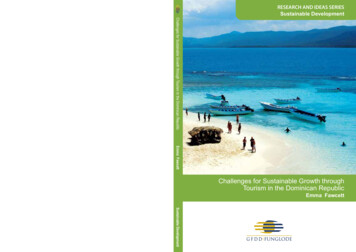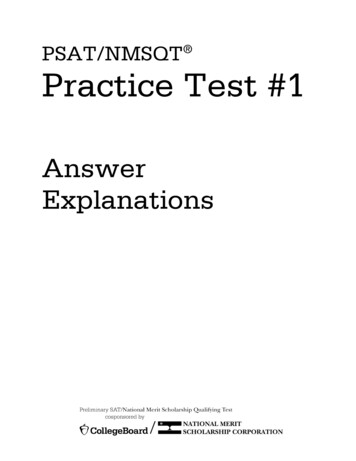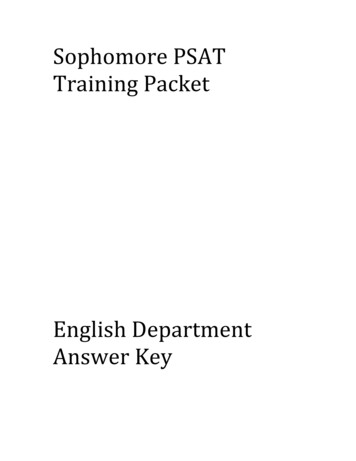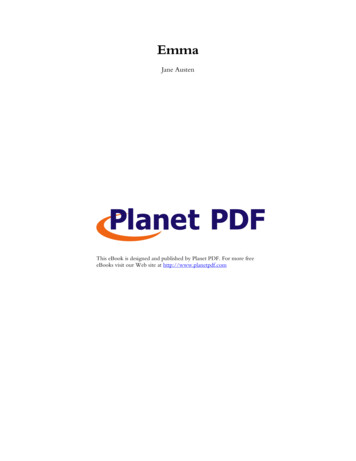
Transcription
RESEARCH AND IDEAS SERIESSustainable DevelopmentChallenges for Sustainable Growth through Tourism in the Dominican RepublicEmma FawcettChallenges for Sustainable Growth throughTourism in the Dominican Republicwww.gfddpublications.org - www.globalfoundationdd.org - www.funglode.orgEducationHealthUrban ble DevelopmentRESEARCH AND IDEAS SERIESEmma Fawcett
Challenges for Sustainable Growth throughTourism in the Dominican Republic
Other books in theResearch and Ideas Series:Distance Education and Challengesby Heitor Gurgulino de SouzaEl Metro and the Impacts of Transportation System Integration in SantoDomingo, Dominican Republicby Carl AllenThe Presence of Africa in the Caribbean, the Antilles and the United Statesby Celsa Albert Bautista et al.Empowerment of Women in Democracies of Developing Countries:The Experience of the Dominican Republicby Rosa Rita ÁlvarezPerspective of Mental Health Development in the Dominican Republicby Yosmayra E. ReyesLocal Capacity to Benefit from Globalization and IncreasingEmployment: The Case of the Dominican Republicby Jose G. CaraballoThe Dominican Tax Reform of 2012 in the Historical and Regional Contextby James E. Hahon Jr.Treating Parkinson's Disease Psychosis with CognitiveBehavioral Therapyby Henry MonteroDominican Republic and P.R. China: Exchange, Trade and Investmentby Yuan LiClimate Change Adaptation in the Dominican Republic:Impact on Coastal Resources and Communitiesby Matt Rosa & Hilary Lohmann
Challenges for Sustainable Growth throughTourism in the Dominican RepublicEmma FawcettThis publication is the result of the author'sparticipation in the Fellows Program in September of 2014.Research and Ideas SeriesSustainable Development
This is a publication of GFDD/FunglodeGlobal Foundation for Democracy and Developmentwww.globalfoundationdd.orgFundación Global Democracia y Desarrollowww.funglode.orgChallenges for Sustainable Growththrough Tourism in the DominicanRepublicCopyright 2016 by GFDD/FunglodeAll rights reserved, including the rightof reproduction in whole or in part inany form.ISBN: 978-9945-590-39-5Editor in ChiefNatasha DespotovicGraphic DesignSofía Cristina TamayoSupervising EditorsSemiramis de MirandaMarc JourdanCoverBeatriz RodilEditorMiryam LópezProofreadingCasey PhillipsCollaborationYamile EusebioMandy SciacchitanoReyna RodríguezLoriel SánchezMariakarla Nodarsewww.gfddpublications.org
Table of ContentsForeword.viiPreface.ixAcknowledgements.3I. Abbreviations.5II. Introduction .7III. The Dominican Republic as a Regional Tourism Leader .9IV. Legal Framework of the Dominican Tourism Industry .11V. Methodology.15VI. Challenges for Sustainable, Inclusive Growth throughTourism – A Look at Existing Literature.17a. Challenge 1: Ensuring Economic Development Reaches theCountry’s Poorest.23i) Barriers to Employment in the Tourism Sector.23ii) Unmeasured (and Perhaps Limited) Linkages to DomesticAgriculture and Other Suppliers.24iii) All-inclusive Model Limits Dispersion of TouristSpending.25b. Challenge 2: Generating Growth in Basic Services andInfrastructure that Keeps Pace with Tourism Development.26i) Planning and Land Use.26ii) Basic Services and Infrastructure for Local Residents.28c. Challenge 3: Environmental and Carrying CapacityConcerns.29i) Beach Erosion, Coral Loss and Other EnvironmentalConcerns.29
ii) Limited State Capacity in Environmental Management .30d. Challenge 4: Modernizing the Framework for Fiscal Incentives .32VII. Policy Recommendations for theDominican Tourism Sector .35a. Put Poverty Issues on the Tourism Agenda.35b. Diversify Touristic Products.36c. Conduct an Independent Value Chain Analysis on the TourismSector to Assess Economic Linkages and Improvements inTourism Statistics .36d. Preserve Public Beach Access.37e. Improvements in Environmental Management .38VIII. Conclusion .41IX. Appendix.43X. References .49Biography.55GFDD.57Funglode.58Fellows Program.59
viiForewordThe Global Foundation for Democracy and Development (gfdd) inthe United States of America and the Fundación Global Democracia and Desarrollo (Funglode), headquartered in Santo Domingo,Dominican Republic, are dedicated to promoting research and awareness in areas crucial to the democratic, social and economic sustainable development of the Dominican Republic and the world. gfddand Funglode organize meetings, educational programs and researchas well as generate studies and publications that contribute to thedevelopment of new perspectives, enrich public policy debate andproposals, and promote the search for innovative solutions and transformative initiatives on a national and international level.gfdd and Funglode are honored to present the publication seriesResearch and Ideas, which offers the results of research projects,academic articles and keynote speeches that address critical issues ofthe contemporary world from local, regional and global points of view.These selected works present scrupulous analysis, introduceinnovative ideas, and transmit inspiration. We hope they will contributeto a better understanding of the world, empowering readers to act inmore informed, efficient, and harmonious ways.On this occasion, the series showcases the work titled Challengesfor Sustainable Growth through Tourism in the Dominican Republic,which presents an analysis of tourism sector in the DominicanRepublic, identifying key challenges in establishing sustainable,inclusive growth through tourism, while proposing a series of policyrecommendations to address these challenges.Natasha DespotovicExecutive Directorgfdd
ixPrefaceThe Dominican Republic has long been viewed primarily as an exporterof sugar, coffee, and tobacco, but in the last decades the service sectorhas overtaken agriculture as the economy's largest employer, due inpart to growth in the tourism industry. Indeed, located about 800 milesfrom Miami between the Caribbean Sea and the Atlantic Ocean, theDominican Republic's proximity to the large North American marketand its tropical climate make it ideal for tourism. The industry itself isconcentrated in the coastal beach towns to the north, east, southeast,southwest and in the capital city of Santo Domingo.In light of these issues and in an effort to enhance publicunderstanding of the tourism sector in the Dominican Republic, thisstudy performed by Emma Fawcett, a PhD candidate in internationalrelations at the School of International Service, American Universityidentifies the key challenges in establishing sustainable, inclusive growththrough tourism. Offering practical policy solutions that highlightthe need for capacity building, partnership creation and the publicparticipation of all relevant stakeholders within the tourism industry atthe national, regional and local level, Ms. Fawcett’s research makes animportant contribution to gfdd’s vision to bring new perspectives andinnovative approaches and solutions to the challenges of contemporarysociety in the Dominican Republic and the world.The Fellows Program provides opportunities to Masters andDoctoral candidates to undertake high-level research in the DominicanRepublic on issues related to democracy and development. Duringtheir studies, researchers work in close coordination with gfdd andFunglode teams as well as with national academic advisors to guidetheir search for information and data. In this study, Ms. Fawcett workedclosely with gfdd/Funglode staff to develop her work, including MandySciacchitano, Loriel Sánchez, and Christty Armand.Ms. Fawcett’s research was carried out in September 2014 indifferent regions of the country, including Santo Domingo and the PuntaCana-Bávaro-Verón-Macao region. During her time in the country,she carried out numerous interviews including, but not limited to, thefollowing organizations: Radhames Aponte, Vice Minister, Ministryof Tourism, Crucito Báez Jiménez, President, Consejo de Desarrollo
xChallenges for Sustainable, Inclusive Growth through TourismEconómico y Social de Verón-Punta Cana, Clara Barriola, Directorof Hospitality School, Universidad pucmm, Paul Beswick, Director ofSocial Projects, Punta Cana Foundation, Miguel Calzada, President,Caribbean Traveling Network, Dr. Pilar Constanzo, Executive Director,Universidad Iberoamericana (unibe) Recinto Cap Cana, Laura delCastillo, Subdirectora Técnica, Consejo Nacional de Competitividad,Department of Ecotourism, Ministry of Environment and NaturalResources, Ramón González, Director, Department of National Accountsand Statistics, Central Bank, Jake Kheel, Environmental Director,Punta Cana Ecological Foundation, Matias Mut, ceo, GrayLine Tours,Juan Carlos Sánchez, Head of Bavaro-Punta Cana Cluster, BienvenidoSantana, Deputy Minister for Marine and Coastal Resources, Ministryof Environment, Ruben Torres, Director, Reef Check, Elizabeth Tovar,President, opetur and turenlaces.We hope that this report on the sustainable development of thetourism industry will encourage debate on economic, democratic andsocial development, not only in the Dominican Republic but also inother Latin America countries.Marc Jourdanun Programs & Outreach Managergfdd
Challenges for Sustainable Growth throughTourism in the Dominican RepublicEmma Fawcett
3AcknowledgementsI wish to thank GFDD and Funglode for providing support and guidanceduring my fieldwork in the Dominican Republic in August-September2014. Additional funding in support of this research was also providedthrough a Doctoral Student Research Award from the Vice Provostfor Research and Dean of Graduate Studies at American University.
5I. AbbreviationsasonahoresDominican Republic National Hotel andRestaurant AssociationidbInter-American Development BankctoCaribbean Tourism OrganizationcncNational Competitiveness CouncilpptPro-poor TourismsmeSmall and Medium-sized EnterprisessidsSmall Island Developing StatesundpUnited Nations Development ProgrammeusaidUnited States Agency for InternationalDevelopmentwttcWorld Travel and Tourism Council
7II. IntroductionThis report explores tourism sector governance in the DominicanRepublic, identifying key challenges in establishing sustainable, inclusivegrowth through tourism. I begin with an overview of the DominicanRepublic’s rise—and future—as a regional tourism leader and the legalframework that has supported the sector’s growth. Then, I review lessonslearned from the existing academic literature on inclusive growththrough tourism and address both recommendations of pro-poortourism scholars and practitioners, and skepticism from those who findthat tourism and development cannot ever be mutually reinforcing.Next, I address four challenges I have identified within the Dominicantourism sector: 1) ensuring economic development reaches the country’spoorest, 2) generating growth in basic services and infrastructurethat keeps pace with tourism development, 3) environmental andcarrying capacity concerns, and 4) modernizing the framework forfiscal incentives. Finally, I provide a series of policy recommendationsto address these challenges.While some of these challenges affect tourism throughout thecountry, it should be noted that this report focuses particularly on theBávaro-Punta Cana tourism pole. As the country’s (and indeed theregion’s) leading destination, it offers important lessons as tourismcontinues to grow nationwide. Furthermore, policy changes directedat the east coast are likely to have the greatest impact on private sectoractors, tourists, and local residents.
9III. The Dominican Republic as a RegionalTourism LeaderAfter several false starts, the Dominican Republic’s rise as a tourismleader took place fairly rapidly. In the mid-twentieth century, privatehoteliers took advantage of the “authoritarian ineptitude” of theTrujillo regime to build a high end tourism infrastructure, much asthey had in Cuba under Batista.1 Provisional governments and politicalinstability hampered the growth of the sector during the 1960s andearly 1970s. While Puerto Plata benefited from government supportand community integration in the mid-1970s, the country’s largestand most successful tourism poles (like Punta Cana) were developedentirely by private investors. The all-inclusive model was seen as theonly option for development along the eastern coast, as the area lackedgovernment-supplied infrastructure, security, or sanitation; provisionof these services in an enclave environment with private investmentprevailed. To attract resort development, the country has offered animpressive package of incentives to developers: long-term (up to 50years) leases of beachfront property, tax exemptions on revenues andimportation of materials for specified periods, a specialized labor codefor the tourism sector, and more.Today, the Dominican Republic welcomes more than five milliontourists a year—more than any other Caribbean country—and is hometo 25% of the region’s hotel rooms. The sector has enjoyed steady growthover the last four decades. Between 1970 and 2000, stayover arrivalsincreased by more than 12% per year. Tourism accounts for 15.3% ofthe Dominican Republic’s gdp (4.7% direct contribution), and 14% ofits employment (4.2% of direct employment). Travel and tourism draw4.6% of total national investment, and visitor exports generated 35.3%of total exports in 2013.2 The tourism sector is highly self-contained, asmost visitors stay in all-inclusive resorts with pre-paid packages, andresort developments are concentrated in four key areas—Puerto Plata,La Romana, Santo Domingo, and Punta Cana.3 95% of the international1 Evan Ward, Packaged Vacations: Tourism Development in the Spanish Caribbean(Gainesville: University Press of Florida, 2008), 157.2 wttc, “Dominican Republic - Travel and Tourism Economic Impact 2014” (WorldTravel and Tourism Council, 2014), www.wttc.org.3 Padilla, Art and Jerome McElroy. “The Tourism Penetration Index in LargeIslands: The Case of the Dominican Republic.” (2005). Journal of Sustainable
10Challenges for Sustainable, Inclusive Growth through Tourismclass rooms in the country are foreign-owned and 80% of them are partof chains. About 65% of the country’s tourists arrive in Punta CanaInternational Airport (one of eight international airports), which issurrounded by all-inclusive hotels. As one industry insider points out,“tourism is the oil of the Dominican Republic.4”While high, low, and shoulder seasons are still present, occupancyrates have become more even throughout the year. As in much of theCaribbean, August is sold-out up to a year in advance to the Europeanmarket. However, the sector’s growth prospects are dismal; accordingto the wttc, the country ranks 155 out of 184 countries for growth inthe 2014 forecast, and 154 out of 184 countries for long-term growth inthe 2014-2024 forecast.5 The 2015 Travel & Tourism CompetitivenessIndex provides further guidance on the sector’s relative strengthsand weaknesses. In terms of overall competitiveness, the DominicanRepublic ranks near the middle of the pack, at 81 of 141 countriesstudied. The Dominican Republic’s prioritization of travel and tourism(rank 7 of 141) is particularly strong, though it fares poorly in safetyand security (120 of 141), price competiveness (110 of 141), andenvironmental sustainability (131 of 141). The country ranks mosthighly in travel and tourism government expenditure, with the sectorcapturing 21.8% of the government budget.6 Whether the DominicanRepublic can sustain the sector’s growth remains to be seen, althoughthe sector is an economic policy priority. President Danilo Medina hasset a goal of reaching 10 million tourists by 2022, which will requireconsiderable efforts in promotion and diversification (of investment,touristic products, and source markets).Tourism. 13 (2005), 357.4 Personal interview with tourism sector entrepreneur5 WTTC, “Dominican Republic - Travel and Tourism Economic Impact 2014.”6 “The Travel & Tourism Competitiveness Report 2015” (World Economic Forum,2015), 136, http://www3.weforum.org/docs/TT15/WEF Global Travel&TourismReport 2015.pdf.
11IV. Legal Framework of the DominicanTourism IndustryThe legal framework for tourism—commencing with Laws 541 and542 in 1969—has evolved little since its inception, and Dominicanscholars and business leaders alike acknowledge that the frameworkis outdated. The 1969 Constitutional Law for Tourism declared statetourism promotion to be “for the public good and in the nationalinterest,” and places emphasis on locations that express the country’scultural heritage. The law also establishes the National Department forTourism within the executive branch, and charges it with establishingprovince-level tourism agencies, engaging in international promotionalcampaigns, and liaising with the private sector. The law also createsregulations and licensing for travel agencies, tourist guides, hotels andrestaurants, and provides sanctions (including fines and possible jailtime) for failure to comply with such regulations.7 The ConstitutionalLaw for the Promotion of the Hotel Industry and the Developmentof Tourism, also passed in 1969, created the Corporation for HotelIndustry Promotion and Tourism Development, responsible for theacquisition, construction, financing, improvement, and maintenanceof hotel and other tourism businesses.8 Law 541 was modified in 1979,which replaced the National Department for Tourism with an expandedSecretary of State for Tourism.Incentive laws followed soon after those establishing stateinstitutions for tourism; the first was passed in 1971. Law 153, entitled“Promotion and Incentive for Tourism Development,” recognizedthe central role of the state in fostering economic development:“it is the essential function of the Dominican State to create thenecessary conditions for expanding the sources of production thatgenerate wealth, and to establish the necessary mechanisms suchthat this results in improved wellbeing that reaches all sectors of theDominican population.” The law provides the following fiscal incentives:1) 100% exemption from income tax, 2) exemption from constructiontaxes, 3) exemption from incorporation taxes, 4) exemption from7 El Congreso Nacional, “Ley No. 541 Orgánica de Turismo de La RepúblicaDominicana,” 1969, http://www.sectur.gob.do/Portals/0/docs/LEY 541-69.pdf.8 El Congreso Nacional, “Ley No. 542 Orgánica de La Corporación de Fomento deLa Industria Hotelera Y Desarrollo del Turismo,” December 22, 1969,http://www.sectur.gob.do/Portals/0/docs/Ley 542-69.pdf.
12Challenges for Sustainable, Inclusive Growth through Tourismfederal and municipal taxes on patents and public performances,and 5) exemption from import taxes, including customs duties, forproducts and materials that are not accessible (in appropriate qualityor at competitive price) in-country, for construction, furnishing andbusiness operations. For most businesses, these incentives last forten years, with the possibility of a five-year extension, but only thoselocated in areas designated as priority tourism poles are eligible. The lawincludes some reporting requirements, such as the filing of architecturalplans and economic feasibility studies with the National TourismDirector. The law was repealed in 1992 and replaced by the Tax Lawof the Dominican Republic.9 (Law 153 did not apply to Punta Canauntil 1986, when Decree 1256-86-479 established Macao-Punta Canaas a priority tourism pole.)Law 158-01, passed in 2001, reestablishes much of the incentivestructure that had been provided under Law 153, but places greateremphasis on sustainable development and environmental protection.The preamble notes that there is remarkable competition to attractforeign investment in important economic sectors, particularly inthe Caribbean. As such, the law provides 100%, ten-year exemptionsfrom income tax, construction permit fees at both the national andmunicipal levels, import duties, and other taxes for all materials(construction, furnishings, etc.) needed to bring the business intooperation. Importantly, violations of environmental law can result inthe loss of incentives. The application of incentives is determined byconfotur (the Council for Tourism Management), which includesrepresentatives from several ministries and Asonahores, the NationalHotel and Restaurant Association. Law 158 also establishes the TourismPromotion Official Fund (tpof), which is managed by the Ministry ofTourism with input from Asonahores. Funding for the tpof comesfrom revenue generated from tourist cards at airports and ports, andfrom other port taxes.10 Under Law 184-02 and 318-04, the tourismpoles to which the exemptions apply were expanded. Under Law 19513, the tax exemptions were extended from 10 years to 15 years, andexpanded to include renovations or refurbishments of facilities that9 Pellerano & Herrera, Attorneys at Law, “Executive Summary: Law on thePromotion of Tourist Development” (Pellerano & Herrera, n.d.), 1,http://www.phlaw.com/imagen?file articulos/275/275.10 Pellerano & Herrera, Attorneys at Law, “Executive Summary:Law on the Promotion of Tourist Development.”
Legal Framework of the Dominican Tourism Industry13are at least 15 years old, provided that the renovation includes at least50% of the facility. Improvements on properties that are at least fiveyears old are also exempt from the tax on the sale of industrializedgoods and services (itbis).As noted, several components of this framework are outdated and/or underdeveloped, which contributes to some of the sector’s challengesin fostering sustainable, inclusive growth. Such challenges, particularlyas relating to the legal framework for tourism, will be further exploredin the sections that follow.
15V. MethodologyFieldwork for this report was supported by the Global Foundationfor Democracy and Development and Fundación Global Democraciay Desarrollo (gfdd/Funglode), which provided me with a researchfellowship commencing in July 2014. I undertook three weeks offieldwork in the Dominican Republic in August and September 2014,in both Santo Domingo and Bávaro. I conducted semi-structuredinterviews with government ministry officials, academics, entrepreneurs,tourism sector employees, activists, consultants, and others associatedwith the tourism industry, employing a snowball sampling eliteinterviewing technique. To ensure that my sampling is not skewed bya heavy presence of one group of stakeholders (e.g. bureaucrats alignedwith one political party), my initial sample included academics andindustry consultants with divergent perspectives on the tourism sector;they referred me to sources that I might have otherwise overlooked byrelying exclusively on policymakers and high-end hoteliers. Interviewswere semi-structured and most were conducted in Spanish. While Iprepared a list of open-ended questions in advance, semi-structuredinterviewing allows the interview to proceed as a conversation, andfor both researcher and interviewee to deviate from the list when theneed arises. It also allowed for the list of topics to evolve as the researchprogressed, as new questions emerged or additional clarificationswere required. All translations from Spanish to English are my own.Interview data is complemented by secondary literature, newspaperreports, and legal documents from the Dominican government andinternational organizations.
17VI. Challenges for Sustainable, Inclusive Growththrough Tourism – A Look at Existing LiteratureMuch of the tourism and development literature is highly critical oftourism’s impacts on environments, cultures, and communities—andsome authors are skeptical of any potential benefits from tourism.This literature notes that tourism is dominated by transnational corporations, and, as such, its revenues are more likely to “leak” back toforeign enterprises rather than forge linkages with local communities.Its authors acknowledge that tourism is both a product and a sourceof globalization, thereby fueling a cycle of continued expansion. Itcalls for increased community involvement and local governance,designed to respect the needs and rights of local people and curtailuninhibited growth. Elements of this literature are sharply critical ofthe private sector and treat local involvement in the tourism planningand maintenance process as a panacea.Reid expresses concern about the “commodification of tourism andits effects on community.11” Like many others in the field, he worriesabout leakages caused by foreign ownership of hotels and other tourismbusinesses, but takes this critique a step further, making a more damningassessment of the political economy of tourism:"It is debatable whether a service industry such as tourism can play asignificant role in creating sufficient capital to induce other development,or whether–given the low-income nature of service jobs in the tourismindustry–it can lead to the development of an entrepreneurial class, asHirschman suggests.12”He concedes that tourism is neither inherently negative norinherently positive, and that planning, management and powerare critical for ensuring sustainable, community-driven tourismdevelopments. Manuel-Navarette and his co-authors see the masstourism discourse as creating a “hegemonic development vision( )enforced by the alignment of the two most powerful groups: governmentand tourism corporations.13”11 Donald G Reid, Tourism, Globalization, and Development Responsible TourismPlanning (London; Sterling, Va.: Pluto Press, 2003), 24.12 Ibid., 79.13 Caribbean: Development Visions, Governance Structures, and CopingStrategies,” Global Environmental Change 21, no. 1 (2011): 252.
18Challenges for Sustainable, Inclusive Growth through TourismThe private sector has struggled—either due to lack of willpoweror to a range of structural challenges, depending on one’s perspective—to create profitable linkages between resorts and local agriculturalsectors. There are a range of factors that hamper tourism and agriculturallinkages in Latin America and the Caribbean, including supply andproduction-related problems (inconsistent or inadequate quantitiesproduced, poor quality, high prices, small economies of scale among localfarmers, poor growing conditions, lack of access to financial services,and inadequate labor supply due to the tourism sector), demandrelated problems (preferences of high-end hotels and their guests forimported goods, distrust of local food due to sanitation concerns), andmarketing/intermediary-related issues (failure to promote local goods,transportation and storage issues, and bureaucracy).14Additionally, “primary production may suffer as a result of land,labor, and capital being invested in tourism,” resulting in suboptimalagricultural production.15 Luxury resorts typically seek out high-endgoods, and budget-friendly all-inclusive desire bargains and familiarityfor their guests—so both ends of the accommodation spectrum bypasslocal producers in favor of imported goods.Moreover, “a compounding element is the demonstration effect,whereby tourist preferences for imported products are adopted by localpopulations, contributing to an overall lack of demand for domesticproducts.16”Hotel owners and local producers alike are often dismayed byCaribbean tourists’ “fish and chip palate,” which when coupled withsupply and marketing issues, limits linkages between tourism and localagricultural sectors.1714 Rebecca Torres and Janet Henshall Momsen, “Challenges and Potentialfor Linking Tourism and Agriculture to Achieve Pro-poor Tourism Objectives,”Progress in Development Studies 4, no. 4 (October 1, 2004): 300–301,doi:10.1191/1464993404ps092oa.15 Regina Scheyvens and Janet Momsen, “Tourism in Small Island States:From Vulnerab
The Dominican Tax Reform of 2012 in the Historical and Regional Context by James E. Hahon Jr. Treating Parkinson's Disease Psychosis with Cognitive Behavioral Therapy by Henry Montero Dominican Republic and P.R. China: Exchange, Trade and Investment by Yuan Li Climate Change Adaptation in the Dominican Republic: Impact on Coastal Resources and .










![INDEX [gfgenealogy ]](/img/44/index-to-wills-cascade-county.jpg)